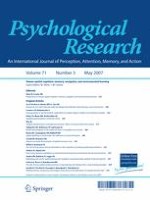01-05-2007 | Original Article
Human non-visual discrimination of gradual turning is poor
Gepubliceerd in: Psychological Research | Uitgave 3/2007
Log in om toegang te krijgenAbstract
We report three measures of the ability of normally sighted adults to discriminate turning while walking blindfolded outdoors. Constant error in selecting line drawings of paths indicated that participants under represent the amount of turning along more curved paths and over represent the amount of turning on less curved paths. Constant error in the direction of pointing to the origin of paths indicated a bias consistent with the direction of turning along more curved paths. Participants produced more accurate drawings of paths as the amount of turning increased. The results suggest that non-visual cues that accompany self movement are not sufficient for accurate representation of large radius curves in geographic scale travel.
